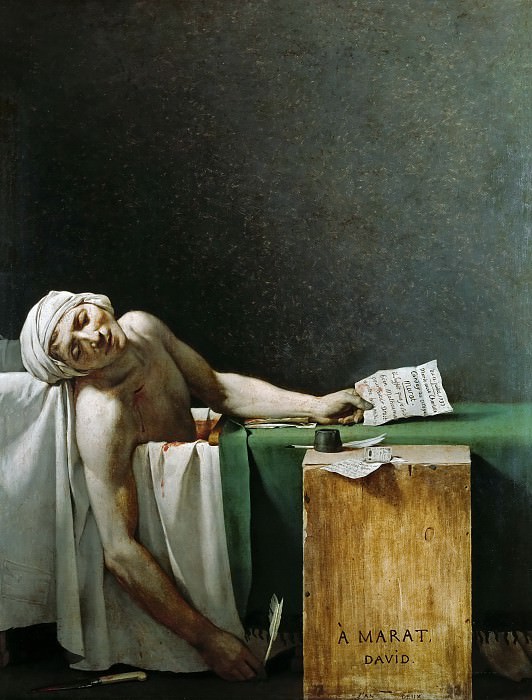Death of Marat Jacques-Louis David (1748-1825)
Jacques-Louis David – Death of Marat
Edit attribution
Download full size: 3097×4082 px (2,8 Mb)
Painter: Jacques-Louis David
Location: Royal Museum of Fine Arts (Koninklijke Musea voor Schone Kunsten), Brussels.
One of the masterpieces of world painting today is considered to be The Death of Marat (1793), painted by the famous French painter Jacques Louis David. Marat was a very good friend of the artist and one of the toughest and most fanatical ringleaders of the bloody revolutionary events in France. He was killed by a decisive stabbing in his bathroom. Therefore, this "portrait" of Marat, ingeniously painted by the author, is a kind of reminder of the tragic events of those times. It is on this canvas that the artist’s heroic realism reaches its best artistic embodiment.
Description of Jacques Louis David’s The Death of Marat
One of the masterpieces of world painting today is considered to be The Death of Marat (1793), painted by the famous French painter Jacques Louis David. Marat was a very good friend of the artist and one of the toughest and most fanatical ringleaders of the bloody revolutionary events in France. He was killed by a decisive stabbing in his bathroom. Therefore, this "portrait" of Marat, ingeniously painted by the author, is a kind of reminder of the tragic events of those times.
It is on this canvas that the artist’s heroic realism reaches its best artistic embodiment. After all, the work was written under the direct impression of real events (David as he saw his friend for the last time).
The masterpiece is distinguished by the combination of historical truth and the emotional power of perception of the artistic image. At the same time, David in the painting is limited to only the most important details to reveal the tragic nature of the image: the slumped lifeless body, the bloody wound, the knife and the letter (which the murderer used to gain access to the room). According to historical accounts, the sick Marat was murdered in the bathtub. And he was taking it at the same time as he was reading the insidious letter of Charlotte Cordet (the murderer).
Distorted by suffering and grief, the character’s features have the distinct character of a portrait. Bright light and clear light and shade set against a dark background emphasize the state of detachment. In the role of antique sarcophagus the viewer perceives the bathtub with draped fabric. And the boulder where the inkwell is set acts as a symbolic tombstone with the epitaph "David to Marat".
The author monumentalized this image, through laconism and heroism its dramatic expressiveness is emphasized. The artist created a masterpiece, similar to the majestically austere monument. Thus, he wanted to immortalize the memory of his friend as a hero of France, and immortalized himself as a brilliant French painter.
Кому понравилось
Пожалуйста, подождите
На эту операцию может потребоваться несколько секунд.
Информация появится в новом окне,
если открытие новых окон не запрещено в настройках вашего браузера.
You need to login
Для работы с коллекциями – пожалуйста, войдите в аккаунт (open in new window).















You cannot comment Why?
In his other hand, he holds a quill, poised as if he was in the act of writing. A makeshift wooden box, serving as a desk, sits beside the tub. On it rests an inkwell, a sharpened quill, and more papers, including the supposed confession or plea from his assassin, Charlotte Corday. The scene is stark and somber, with a dark, almost black background that amplifies the tragic realism of the moment. The lighting is dramatic, highlighting Marats pale, lifeless body and the objects surrounding him.
The painting carries significant subtext. David, an ardent supporter of the Revolution and a friend of Marat, intended to portray him as a martyr for the cause. The composition draws parallels to classical representations of Christs deposition, emphasizing Marats sacrifice and innocence. The inscription on the box, À Marat, David, serves as a personal dedication and a historical testament. The letter in his hand, detailing a desperate plea, emphasizes Marats role as a champion of the people, alleviating misfortune even in his dying moments. The overall effect is a powerful piece of political propaganda, designed to evoke sympathy and solidify Marats image as a heroic victim of counter-revolutionary forces.